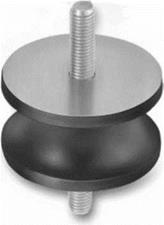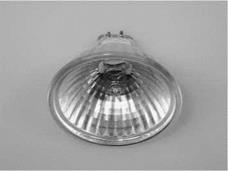The mounting of halogen light bulbs into glass reflectors is an example of applications where organic adhesives fail. Long-term resistance to elevated temperatures from 300 °C to 1500 °C can only be achieved with inorganic systems (Figure 8.92).
Inorganic, air-drying adhesives are usually water glass formulations with oxidic fillers (aluminum oxide, silicon oxide, zirconium oxide, magnesium oxide, mica, etc.).
|
Figure 8.91 A rubber-steel damping element (Schwingmetall®). |
Water glass is produced from silica by dissolving quartz in molten alkaline carbonate. Water glass is obtained in aqueous solution (2-4 moles of SiO2 per mole sodium or potassium oxide) [120].
A filled water glass sets by the evaporation of water, a process which is similar to the physical setting of organic adhesives. Setting is enhanced by heating to up to +60 ° C and by circulating air. Higher temperatures at the start of the setting process may impair the bond-line due to higher water-vapor pressure causing pores or cracks in the adhesive layer. Inorganic adhesives are not suited to large-area bonding. Products which contain components that are more soluble in water set by crystallization, with the crystals growing during the course of the setting process. At room temperature, however, this process may continue for weeks.
Colloid oxidic fillers set by the formation of hydrated gel, a process that requires less time than does crystalline setting.
Chemically setting inorganic adhesives usually contain phosphates and alkaline silicates or alumosilicates. Depending on the type of adhesive used, the setting
|
Figure 8.92 A halogen light bulb (20 W) mounted in a glass reflector using inorganic adhesive. |
process is enhanced by heating to 150 °C [121]. In an acid medium, water-soluble, low-molecular-weight silica is transformed into amorphous SiO2 with a threedimensional network structure, which is insoluble in water, by a condensation reaction that splits off water.
The filler, purity and particle-size distribution mainly determine the properties of an inorganic adhesive. Contaminations in the filler may impair, for example, the electrical properties, whereas a nonuniform grain-size distribution may disturb the three-dimensional network structure, and hence the mechanical properties.
Today, only a few knowledgeable manufacturers are capable of producing high — temperature-resistant adhesives.
 22 января, 2016
22 января, 2016  Pokraskin
Pokraskin 

 Опубликовано в рубрике
Опубликовано в рубрике 